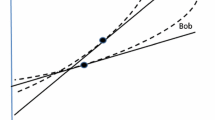Abstract
Typical welfare and inequality measures are required to be Lorenz consistent which guarantees that inequality decreases and welfare increases as a result of a progressive transfer. We explore the implications for welfare and inequality measurement of substituting the weaker absolute differentials and deprivation quasi-orderings for the Lorenz quasi-ordering. Restricting attention to distributions of equal means, we show that the utilitarian model – the so-called expected utility model in the theory of risk – does not permit one to make a distinction between the views embedded in the differentials, deprivation and Lorenz quasi-orderings. In contrast it is possible within the dual model of M. Yaari (Econometrica 55 (1987), 99–115) to derive the restrictions to be placed on the weighting function which guarantee that the corresponding welfare orderings are consistent with the differentials and deprivation quasi-orderings respectively. Finally we drop the equal mean condition and indicate the implications of our approach for the absolute ethical inequality indices.
Similar content being viewed by others
References
Amiel, Y. and Cowell, F.A.: Measurement of income inequality: Experimental test by questionnaire, J. Public Econ. 47 (1992), 3–26.
Atkinson, A.B.: On the measurement of inequality, J. Econom. Theory 2 (1970), 244–263.
Ballano, C. and Ruiz-Castillo, J.: Searching by questionnaire for the meaning of income inequality, Revista Española Econ. 10 (1993), 233–259.
Berge, C.: Topological Spaces, Including a Treatment of Multi-Valued Functions, Vector Spaces and Convexity, Oliver and Boyd, Edinburgh, 1963.
Bickel, P.J. and Lehmann, E.L.: Descriptive statistics for non-parametric models III. Dispersion, Annals of Statistics 4 (1976), 1139–1158.
Blackorby, C., Bossert, W. and Donaldson, D.: Income inequality measurement: The normative approach, In: Silber (ed.), Handbook of Income Inequality Measurement, Kluwer Academic Publishers, Dordrecht, 1999, pp. 133–157.
Bossert, W. and Pfingsten, A.: Intermediate inequality: Concepts, indices and welfare implications, Math. Social Sci. 19 (1990), 117–134.
Chakravarty, S.R.: Relative deprivation and satisfaction orderings, Keio Econ. Stud. 34 (1997), 17–32.
Chakravarty, S.R. and Moyes, P.: Individual welfare, social deprivation and income taxation, Econom. Theory 21 (2003), 843–869.
Chateauneuf, A.: Decreasing inequality: An approach through non-additive models, CERMSEM Discussion Paper, Université Paris I, 1996.
Chateauneuf, A., Cohen, M. and Meilijson, I.: Four notions of mean-preserving increase in risk, risk attitudes and applications to the rank-dependent expected utility model, J. Math. Econ. 40 (2004), 547–571.
Chateauneuf, A. and Moyes P.: Does the Lorenz curve really measure inequality? GRAPE Discussion Paper, Université Montesquieu Bordeaux IV, 2004.
Cheng, K.W.: Majorization: Its extensions and the preservation theorems, Technical Report #121, Department of Statistics, Stanford University, 1977.
Chew, S.H.: A generalization of the quasilinear mean with application to the measurement of income inequality and the decision theory resolving the Allais paradox, Econometrica 51 (1983), 1065–1092.
Dalton, H.: The measurement of the inequality of incomes, Economic J. 30 (1920), 348–361.
Ebert, U.: Measurement of inequality: An attempt at unification and generalization, Soc. Choice and Welfare 5 (1988), 59–81.
Ebert, U. and Moyes, P.: An axiomatic characterization of the Yitzhaki’s index of individual deprivation, Econ. Letters 68 (2000), 263–270.
Ebert, U. and Moyes, P.: Welfare, inequality and the transformation of incomes. The case of weighted income distributions, In: P. Moyes, C. Seidl and A.F. Shorrocks (eds.), Inequalities: Theory, Experiments and Applications, Journal of Economics 9 (Supplement) (2002), pp. 9–50.
Fields, G.S. and Fei, J.C.H.: On inequality comparisons, Econometrica 46 (1978), 305–316.
Gaertner, W. and Namazie, C.: Income inequality, risk, and the transfer principle: A questionnaire-experimental investigation, Math. Social Sci. 45 (2003), 229–245.
Hardy, G.H., Littlewood, J.E. and Polya, G.: Inequalities, 2nd edn, Cambridge University Press, Cambridge, 1952.
Harrison, E. and Seidl, C.: Perceptional inequality and preference judgements: An empirical examination of distributional axioms, Public Choice 79 (1994), 61–81.
Hey, J.D. and Lambert, P.J.: Relative deprivation and the Gini coefficient: Comment, Quart. J. Econ. 95 (1980), 567–573.
Kakwani, N.C.: The relative deprivation curve and its applications, J. Bus. Econ. Statist. 2 (1984), 384–405.
Kolm, S.-C.: The optimal production of social justice, In: Margolis and Guitton (eds.), Public Economics, Macmillan, London, 1969, pp. 145–200.
Kolm, S.-C.: Unequal inequalities I, J. Econom. Theory 12 (1976), 416–442.
Marshall, A.W. and Olkin, I.: Inequalities: Theory of Majorization and its Applications, Academic Press, New York, 1979.
Marshall, A.W., Olkin, I. and Proschan, F.: Monotonicity of ratios of means and other applications of majorization, In: Shisha (ed.), Inequalities, Academic Press, New York, 1967, pp. 177–190.
Moyes, P.: A new concept of Lorenz domination, Econ. Letters 23 (1987), 203–207.
Moyes, P.: Stochastic dominance and the Lorenz curve, In: Silber (ed.), Handbook of Income Inequality Measurement, Kluwer Academic Publishers, Dordrecht, 1999, pp. 133–157.
Preston, I.: Ratios, differences and inequality indices, Institute for Fiscal Studies Working Paper No. W90-9, 1990.
Quiggin, J.: Generalized Expected Utility Theory. The Rank-Dependent Model, Kluwer Academic Publishers, Boston, 1993.
Runciman, W.G.: Relative Deprivation and Social Justice, Routledge and Kegan Paul, London, 1966.
Thon, D.: Redistributive properties of progressive taxation, Math. Social Sci. 14 (1987), 185–191.
Weiss, Y. and Fershtman, C.: Social status and economic performance: A survey, Europ. Econ. Rev. (1998), 801–820.
Weymark, J.: Generalized Gini inequality indices, Math. Social Sci. 1 (1981), 409–430.
Yaari, M.E.: The dual theory of choice under risk, Econometrica 55 (1987), 99–115.
Yaari, M.E.: A controversial proposal concerning inequality measurement, J. Econom. Theory 44 (1988), 381–397.
Yitzhaki, S.: Relative deprivation and the Gini coefficient, Quart. J. Econ. 93 (1979), 321–324.
Author information
Authors and Affiliations
Corresponding author
Rights and permissions
About this article
Cite this article
Chateauneuf, A., Moyes, P. Lorenz non-consistent welfare and inequality measurement. J Econ Inequal 2, 61–87 (2004). https://doi.org/10.1007/s10888-004-4383-7
Issue Date:
DOI: https://doi.org/10.1007/s10888-004-4383-7




